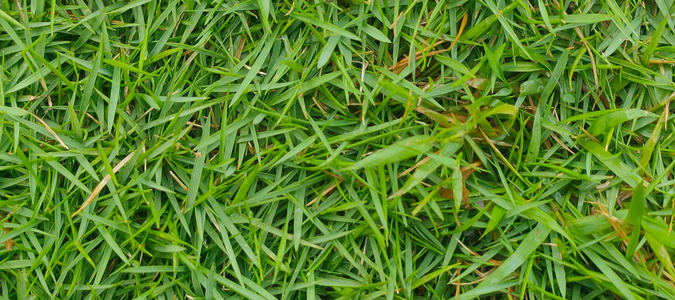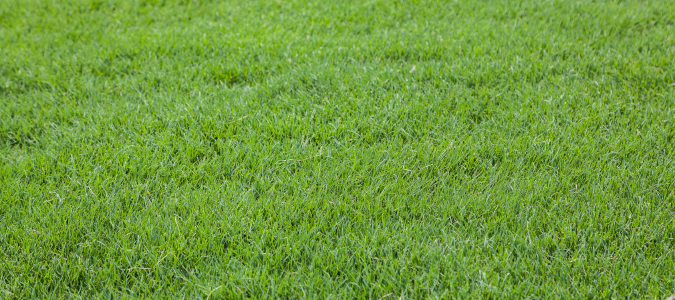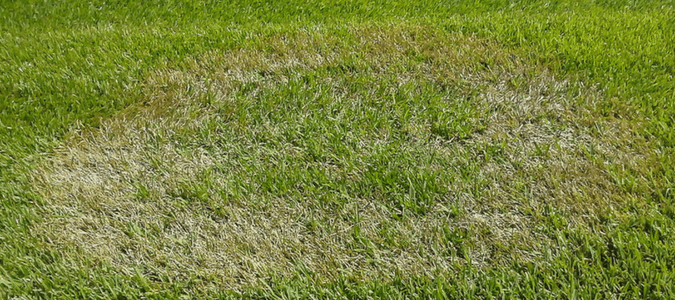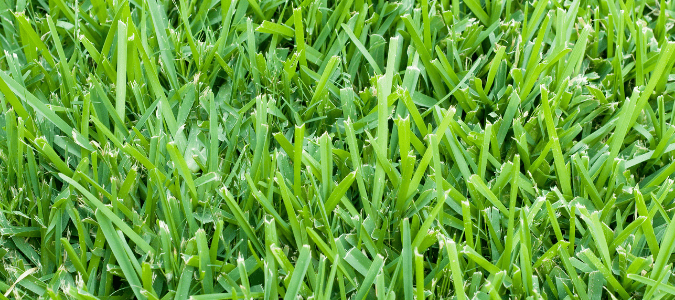Zoysia grass and Bermuda grass may seem similar in appearance but have different characteristics and needs. They are popular options for warm climates such as Texas and Florida, as they thrive in the heat.
Zoysia Grass Appearance, Care and Maintenance
Zoysia grass, pictured above, is a vibrant green grass that is relatively low maintenance. Since it thrives in warm weather, it can handle drought-like conditions and maintain its bright color. It can also survive bouts of cold weather and has a higher shade tolerance than Bermuda grass. However, zoysia grass takes longer to recover from damage than Bermuda grass.
Another benefit of zoysia grass is that it is an invasive species that can overtake weeds, especially when planted as sod. Homeowners can save time on weed pulling with zoysia grass. It only requires a little water or mowing.
A key difference between zoysia grass and Bermuda grass is blade width. Zoysia grass can range from two to seven millimeters in width, whereas Bermuda grass is between one and a half and two millimeters in width. Zoysia grass also has a slightly taller mowing height than Bermuda grass.
Regarding soil, zoysia grass prefers clay, sandy and loamy options, and fertilizers with lower nitrogen inputs than Bermuda grass. The soil pH should be between six and seven for zoysia grass to thrive.
The main pests that infest zoysia grass are chinch bugs and billbugs, and the potential diseases are brown patch, leaf spots and rust.
Contact a lawn care specialist to see if zoysia grass is right for you. They can inspect your property’s conditions before making the right recommendation for your home.
Bermuda Grass Appearance, Care and Maintenance
Bermuda grass, pictured above, also thrives in warm weather. It also does not tolerate shade. It has a bright green color but is slightly thinner and shorter than zoysia grass. Bermuda grass requires full sun to thrive and maintain its vibrancy.
Like zoysia grass, Bermuda grass is an invasive species but grows faster. Some homeowners appreciate how quickly it grows, while others prefer slower growth to reduce mowing frequency. This fast growth means that Bermuda grass will recover fastest after damage. Both types of grass are prone to overgrowth and do not require a lot of watering.
Bermuda grass has a softer feel than zoysia grass. It can tolerate various soil types, including deep sands and heavy clays, and prefers high-nitrogen fertilizers.
Lastly, pests that may infest Bermuda grass include Bermuda grass mites, grubs, fall armyworms and sod webworms. Its main diseases are dollar spot, pythium, leaf spots, brown spots and spring dead spots.
If you are unsure whether zoysia grass or Bermuda grass is the right choice for your lawn, call a lawn care specialist for help. They can advise you on the best choice based on your light, soil and weather conditions.
Types of Fungus in Zoysia Grass
Homeowners love zoysia grass because it is less prone to diseases and fungal growth than other types of grass. However, there are still some risks, especially when the grass is wet for a long period of time.
For example, the most harmful fungus that can infect zoysia grass is called brown patch. This disease leaves brown circular patches on the blades of zoysia grass. The patches infect areas two to three feet wide, and you can tell it is coming when the grass starts to wilt.
Brown patch can kill zoysia grass, and zoysia grass recovers very slowly.
Next, a fungus called Fusarium patch, also known as pink snow mold, attacks zoysia grass. This mold has the appearance of water spots at first, but then it grows orange, brown, yellow and red spots as it grows.
Dollar spot fungus is similar to brown patch, but it causes the turf to sink. When patches of dollar spots merge together, it can create a large sunken area. In humid climates, dollar spot also produces white cobweb-like growth. There are also fungal infections that produce powdery mildew instead of spots.
Fungal infections are dangerous for zoysia grass because they kill the grass at the root. They are also hard to treat, so prevention is important.
To prevent zoysia grass fungus, aerate your lawn every spring. Fungus grows when zoysia grass is too moist, so maintaining proper drainage is key. Homeowners can also apply fungicides twice a year in the spring and fall. Zoysia grass should also be fertilized with fertilizer that is high in nitrogen.
It’s important not to overwater zoysia grass. It should be watered in the early morning so that several hours of sunlight dry the water off the blades. Limiting shade is another way to keep it dry and healthy.
Homeowners should also keep their yards tidy to prevent the spread of fungus since debris welcomes diseases and pests.
To treat zoysia grass fungus, there are several fungicide options. However, It’s also important to minimize the spread. Clean up all yard clippings after mowing your lawn so they do not spread the fungus further.
If you think your zoysia grass has a fungal disease, contact a lawn care specialist. They will identify the fungus and provide effective treatment. They can also advise you on future prevention so that you don’t have to deal with zoysia grass problems.
Zoysia Grass Versus St. Augustine Grass
Another type of grass that may seem similar to zoysia grass is St. Augustine grass. Like zoysia grass, there are several color options with St. Augustine grass, from emerald green to blue-green. It also has wider blades than zoysia grass. St. Augustine grass blades measure between eight and nine millimeters. It also grows taller than zoysia grass and has a mowing height of two to four inches.
St. Augustine grass, pictured above, has a more coarse feel to it, as opposed to soft zoysia grass. However, it can tolerate a little more shade than zoysia grass.
St. Augustine grass prefers sandy soil and fertilizer with lower nitrogen inputs. The proper pH level for St. Augustine grass to thrive is between five and eight and a half.
The main pests that infest St. Augustine grass include grubworms, fall armyworms and chinchbugs. Grey leaf spots, brown patch and take-all patch are the main disease threats.
Whether or not zoysia grass or St. Augustine grass is right for you will depend on the look and feel you want, weather conditions, maintenance expectations and other factors. Contact a lawn care specialist to help you decide which type of grass to go with. In addition, they can help you with St. Augustine grass care.
A lawn care specialist will consider all the factors before making a recommendation, and they can lay and nurture the grass for you. They can also create a regular maintenance schedule for zoysia grass, so it stays healthy and beautiful.
Keep Your Grass Healthy and Beautiful
Choosing the right type of grass for your lawn is not always easy. Thankfully, zoysia, Bermuda and St. Augustine grass are all great options, especially for warm climates. The main differences between the three types of grass are their blade width and height, drought tolerance and maintenance needs.
All types of grass can contract fungal diseases. It’s important to prevent them by keeping your soil dry and maintaining proper drainage.
Still not sure which type of grass you should plant on your lawn? Contact a lawn care specialist today. No matter your choice, they will help you keep your lawn vibrant, healthy and beautiful with proper care and maintenance.
ABC Can Repair and Maintain Your Zoysia Grass
Knowing which type of grass is best for your lawn can be difficult. Instead of playing a guessing game with your grass, contact ABC Home & Commercial Services. Our lawn care professionals can create a lawn care plan to keep your grass healthy and green.




